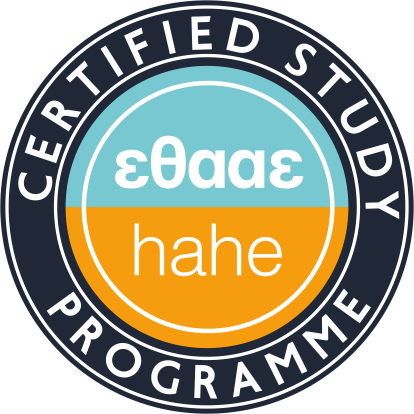Translation Greek ‒ German III
Teaching Staff: Seel Olaf Immanuel
Course Code: DE-3237
Gram-Web Code: ΜΕ2503Ε
Course Category: Specific Background
Course Type: Compulsory
Course Level: Undergraduate
Course Language: German / Greek
Semester: 3rd
ECTS: 3
Total Hours: 2
Erasmus: Not Available
Short description: This course focuses on the Greek to German translation of travel/tourism texts which include many cultural elements, have clear vocative function, pertain to the textual category of general texts and can be rather lucrative for the professional translator, for they are, amongst others, a frequent translation task. The students learn to deal with the linguistic, cultural and textual problems that emerge from the translation of this particular text type and with this particular translational directionality and they get familiar with the basic principles of the translation of travel/tourism texts from Greek to German. Moreover, the students learn how to translate such texts with the same function, as well as with divergent functions depending on the Skopos of each text. The translational approach used in this course is a functional one.
Upon completion of the course, students will be able to:
- understand the textual, linguistic and cultural particularities of the travel/tourism texts (with emphasis on the websites of local travel/tourism agencies and organizations, such as the website of the Greek National Tourism Organization) which include many cultural elements, have clear vocative function and pertain to the textual category of general texts
- identify and deal with the linguistic, cultural and textual problems that arise when translating this particular text type
- have as sufficient command of the basic principles of the functional translation theory
- understand and apply the translational approach to text analysis
- effectively deal with challenges related to the translation of place names, first names, dialects, idioms. In particular, they will be able to choose the most appropriate techniques and justify their translation choices
- translate travel/tourism texts with the same function as well as with divergent functions
- understand the cultural differences between German and Greek
- create bilingual term bases on issues that are central to travel/tourism texts.
Week 1: The main textual, linguistic and cultural particularities of the travel guides and brochures are introduced and the central principles for their translation are presented. The first source text to be translated with the same function by the students is analyzed in class (travel/tourism text 1).
Week 2: The translation (of the travel/tourism text 1) is presented by 1-2 students in class with the help of electronic means (computer, projector). Their translation is then discussed, analyzed and compared, contrasted with the translation of the other course participants and, as far as needed, corrected. Source text number two (travel/tourism text 2) is distributed to the students to be translated with the same function for the next session.
Week 3: The translation (of the travel/tourism text 2) is presented by 1-2 students in class with the help of electronic means (computer, projector). Their translation is then discussed, analyzed and compared, contrasted with the translation of the other course participants and, as far as needed, corrected. Source text number three (travel/tourism text 3) is distributed to the students to be translated with the same function for the next session.
Week 4: The translation (of the travel/tourism text 3) is presented by 1-2 students in class with the help of electronic means (computer, projector). Their translation is then discussed, analyzed and compared, contrasted with the translation of the other course participants and, as far as needed, corrected. Source text number four (travel/tourism text 4) is distributed to the students to be translated with the same function for the next session.
Week 5: The translation (of the travel/tourism text 4) is presented by 1-2 students in class with the help of electronic means (computer, projector). Their translation is then discussed, analyzed and compared, contrasted with the translation of the other course participants and, as far as needed, corrected. Source text number five (travel/tourism text 5) is distributed to the students to be translated with the same function for the next session.
Week 6: The translation (of the travel/tourism text 5) is presented by 1-2 students in class with the help of electronic means (computer, projector). Their translation is then discussed, analyzed and compared, contrasted with the translation of the other course participants and, as far as needed, corrected. Source text number six (travel/tourism text 6) is distributed to the students to be translated with the same function for the next session.
Week 7: The translation (of the travel/tourism text 6) is presented by 1-2 students in class with the help of electronic means (computer, projector). Their translation is then discussed, analyzed and compared, contrasted with the translation of the other course participants and, as far as needed, corrected. Source text number seven (travel/tourism text 7) is distributed to the students to be translated with a divergent function for the next session.
Week 8: The translation (of the travel/tourism text 7) is presented by 1-2 students in class with the help of electronic means (computer, projector). Their translation is then discussed, analyzed and compared, contrasted with the translation of the other course participants and, as far as needed, corrected. Source text number eight (travel/tourism text 8) is distributed to the students to be translated with a divergent function for the next session.
Week 9: The translation (of the travel/tourism text 8) is presented by 1-2 students in class with the help of electronic means (computer, projector). Their translation is then discussed, analyzed and compared, contrasted with the translation of the other course participants and, as far as needed, corrected. Source text number nine (travel/tourism text 9) is distributed to the students to be translated with two divergent functions for the next session.
Week 10: The translation (of the travel/tourism text 9) is presented by 1-2 students in class with the help of electronic means (computer, projector). Their translation is then discussed, analyzed and compared, contrasted with the translation of the other course participants and, as far as needed, corrected. Source text number ten (travel/tourism text 10) is distributed to the students to be translated with two divergent functions for the next session.
Week 11: The translation (of the travel/tourism text 10) is presented by 1-2 students in class with the help of electronic means (computer, projector). Their translation is then discussed, analyzed and compared, contrasted with the translation of the other course participants and, as far as needed, corrected. Source text number eleven (travel/tourism text 11) is distributed to the students to be translated with three divergent functions for the next session.
Week 12: The translation (of the travel/tourism text 11) is presented by 1-2 students in class with the help of electronic means (computer, projector). Their translation is then discussed, analyzed and compared, contrasted with the translation of the other course participants and, as far as needed, corrected. Source text number twelve (travel/tourism text 12) is distributed to the students to be translated with three divergent functions for the next session.
Week 13: The translation (of the travel/tourism text 12) is presented by 1-2 students in class with the help of electronic means (computer, projector). Their translation is then discussed, analyzed and compared, contrasted with the translation of the other course participants and, as far as needed, corrected. Conclusions are drawn with regard to the translation οf the general text type of travel/tourism and to the translational directionality Greek to German. Furthermore, conclusions are also drawn by the students on the helpfulness of the theoretical tools of functional translation theory with regard to the translation of this particular text type.
Suggested reading:
Holz-Mänttäri, J. (1990), “Funktionskonstanz – eine Fiktion? Übersetzungswissenschaft und Sprachmittlerausbildung. Akten der I. Internationalen Konferenz, Humboldt-Universität zu Berlin, 1988. Ed. Heidemarie Salevsky. Berlin: Humboldt-Universität, σελ. 66-74.
N Nord, C. (2014), Η μετάφραση ως στοχευμένη δραστηριότητα – Εισαγωγή στις λειτουργικές προσεγγίσεις. [Μετ. Σίμος Π. Γραμμενίδης, Δέσποινα Δ. Λάμπρου]. Αθήνα: Δίαυλος.
Seel, O. I. (2015), Εισαγωγή στη γενική μετάφραση. Μια λειτουργική προσέγγιση με βάση το ζεύγος γλωσσών ελληνικά/γερμανικά και τα κειμενικά είδη συνταγών μαγειρικής, διαφημιστικών κειμένων και τουριστικών οδηγών. (Ηλεκτρονικό βιβλίο στο πλαίσιο του προγράμματος «Κάλλιπος», Προσβάσιμο στο: (https://repository.kallipos.gr/handle/11419/2568) ή απευθείας στο (https://repository.kallipos.gr/pdfviewer/web/viewer.html?file=/bitstream/11419/2568/7/00_master_document_interractive.pdf).
Vermeer, H. J. (31992),Skopos und Translationsauftrag - Aufsätze. Frankfurt am Main: IKO-Verlag für interkulturelle Kommunikation (thw; 2).
Face-to-face delivery/Electronic source texts and bibliography is offered by the instructor of this course through e-class. All work at home and in class is based on this material. The students are asked to produce the translations of the given source text(s) and to present their work in class by using the computer and projector.
Use of ICT in teaching.
Final written exams.
Back
Undergraduate
Secretariat
Galinos Building (1st floor)
Corfu, GR-49132
Open to the public:
Mon, Wed, Fri: 11am - 1pm
Tue, Thu: 11am - 1pm (Erasmus+)
 E-Class Platform
E-Class Platform
 eSecretariat
eSecretariat
 Webmail
Webmail
 Learning Material Management
Learning Material Management
 Internship Portal
Internship Portal
 Library
Library





 Translation Greek ‒ German III
Translation Greek ‒ German III
